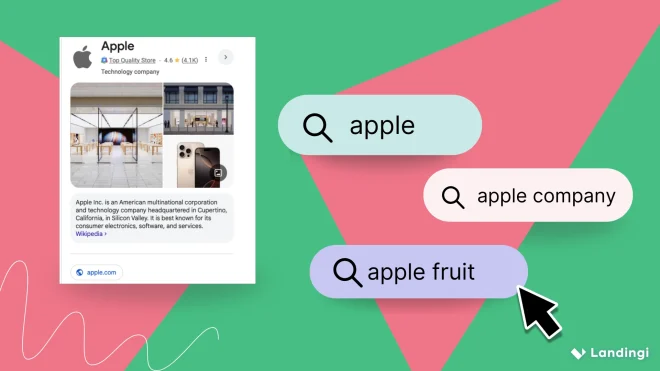Greyhat SEO operates in the middle ground between fully approved practices and clearly banned methods. According to Loganix, it uses methods “not strictly against Google’s guidelines but a little outside best practice”. A 2023 study by Search Engine Journal highlights the tangible risks of grey hat SEO: 34% of websites employing these techniques faced penalties from Google. Yet, still many marketers are drawn to its promise of accelerated results (20–30 % faster visibility than pure white‑hat methods within a month), navigating this risky zone in pursuit of a competitive edge.
If you’re wondering how to navigate this complex and often misunderstood area of digital marketing, this guide is for you. We’ll demystify greyhat SEO, clearly define it, and explore its potential benefits for your digital strategy. You’ll discover practical steps on how to carefully implement and continually improve these methods, all while aiming to manage the inherent risks. If you’re ready to explore the nuanced world between traditional best practices and outright manipulation, understanding how to apply grey hat tactics strategically is key to gaining a true competitive advantage.
There’s one rule: Use greyhat wisely for smart, controlled growth.

What is Greyhat SEO in Google?
Greyhat SEO is a mix of legal and risky SEO techniques. It falls between whitehat SEO (fully compliant with Google’s guidelines) and blackhat SEO (which violates them outright). Greyhat tactics are not officially banned but carry a higher risk of penalties if detected.
These methods aim to manipulate search engine rankings without clearly violating Google‘s rules. For example, creating doorway pages, spinning content with slight modifications, or using expired domains for authority can all fall under greyhat SEO. While they might boost short-term visibility, they often don’t build long-term value and can trigger penalties during algorithm updates.
Google does not officially categorize “grey hat” as a separate SEO method. Marketers use this term to describe uncertain or ambiguous practices – ones that haven’t yet been penalized but could be in the future.
Why is Greyhat SEO Important?
Greyhat SEO matters, as it provides a strategic middle ground between the slow, sustainable gains of whitehat SEO and the high–risk, aggressive tactics of blackhat SEO. These approaches often sit in a legal gray area – neither fully clean nor blatantly deceptive – and serve as a shortcut for growth before stricter algorithm changes catch up.
Every SEO expert will tell you that greyhat techniques usually don’t have long-term benefits, which is actually the core of SEO efforts. However, these tactics can give some value when used wisely – they can temporarily boost domain visibility, increase click–through rates, and test what search engines tolerate. This flexibility attracts marketers aiming for faster gains while still maintaining a margin of plausible deniability.
Understanding these methods also helps ethical SEOs recognize risk boundaries. It highlights where Google’s enforcement gaps exist and shows how aggressive players influence ranking shifts, link dynamics, and traffic patterns. As a result, it plays a key role in shaping content strategy, risk planning, and competitive analysis.
Smart SEO strategies start with smart pages. Build high-performance landing pages with Landingi today!
6 Easy Steps for Implementing and Improving Greyhat SEO Methods
Venturing into grey hat SEO means navigating a nuanced landscape where caution is paramount. It’s a realm where grey hat practices aren’t just about the technique itself, but profoundly about the objectives and intentions driving it. These steps will walk you through making grey hat SEO safe, or at least safer, by showing you how to strategically use these methods to boost your site’s ranking while meticulously managing risk.
Let’s dive into a structured approach that prioritizes smart execution over reckless abandon.
1. Select Greyhat Techniques
When exploring grey hat SEO, the first thing to do is carefully pinpoint the tactics that best match your specific objectives, and, crucially, your comfort level with risk. This isn’t a “one size fits all” approach. Common options you might consider include:
- Engaging in reciprocal link exchanges with carefully chosen partners,
- Employing controlled keyword stuffing, where you subtly integrate keywords without sacrificing natural readability,
- Moderately using content spinning or automation to generate variations,
- Acquiring expired domains that already boast strong, relevant backlink profiles,
- Strategically building or leveraging Private Blog Networks (PBNs),
- Creating multiple social media or bookmarking accounts to amplify link signals,
- Exploring link buying or sponsored content on genuinely reputable sites.
Example: If your goal is to build authority for a new niche site quickly and you have a moderate risk tolerance, you might focus on acquiring a few high-quality, expired domains with relevant past content and strong existing backlinks, rather than diving into large-scale PBN creation or aggressive content spinning.
2. Evaluate Risks
Once you’ve eyed a few grey hat techniques, the next, absolutely critical step is to evaluate their inherent risks. This isn’t a set-it-and-forget-it deal, as the SEO rules constantly shift. You need to stay hyper-vigilant and continuously updated on potential algorithm changes from Google and other search engines. What might be mildly effective today could trigger a severe penalty tomorrow.
Every grey hat tactic carries a “penalty risk” – the chance that Google’s algorithms will detect it, resulting in a ranking drop or even de-indexing your site. Your job is to assess these penalty risks against the potential short-term gains. It’s a delicate balancing act, and you must always strive to balance grey hat efforts with robust, foundational white hat SEO practices. Think of white hat as your reliable way to grow steadily over time – grey hat acts like a wild boost for quick changes.
Example: Building a small Private Blog Network (PBN) can provide quick backlinks. However, there is a high risk that Google will find and punish it if it’s not done carefully. A more balanced approach would involve using the PBN for a small portion of your link profile while investing heavily in legitimate content marketing and outreach (white hat) for the majority of your links, mitigating the overall risk to your site.
3. Implement Greyhat Tactics (Cautiously!)
With your chosen tactics in hand and risks thoroughly assessed, it’s time to move into the implementation phase. Remember, precision and finesse are your best allies here – these aren’t moves to be executed carelessly.
Improve your SEO tactics and turn clicks into conversions with optimized pages from Landingi.
Reciprocal Link Building
Reciprocal link building involves exchanging links with other web pages, where two sites mutually agree to build backlinks to each other. While often seen as a risky grey area in link-building tactics, it can be done safely if approached with extreme caution and a focus on genuine value.
To avoid being flagged for spammy links, prioritize exchanges with highly relevant, reputable sites that genuinely complement your content and audience. The key is to secure quality links that provide real value to both parties, making the exchange look natural and user-focused rather than manipulative.
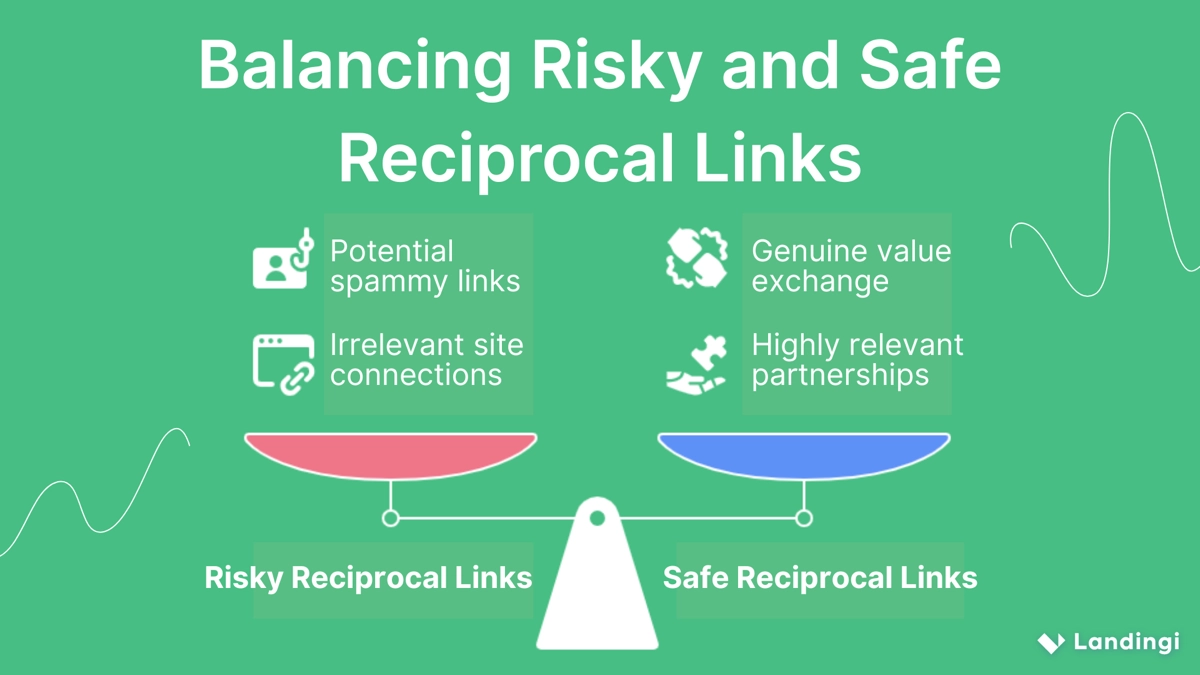
Example: A blog specializing in organic gardening might contact a reputable online store selling seeds. If both sites genuinely offer value to a similar audience, they could agree to link to each other’s relevant articles or product pages, making the connection logical and beneficial for their readers.
Controlled Keyword Stuffing
Controlled keyword stuffing involves carefully integrating target keywords into your content without sacrificing readability or user experience. Unlike aggressive, outdated tactics in creating content, the goal here is to reinforce your topic for search engines while primarily serving search intent. It’s about optimizing naturally, ensuring your in-depth content remains highly valuable and engaging for readers. When done safely, this technique supports your efforts to achieve better search rankings by signaling relevance, maintaining the focus on delivering genuinely high-quality content above all else.
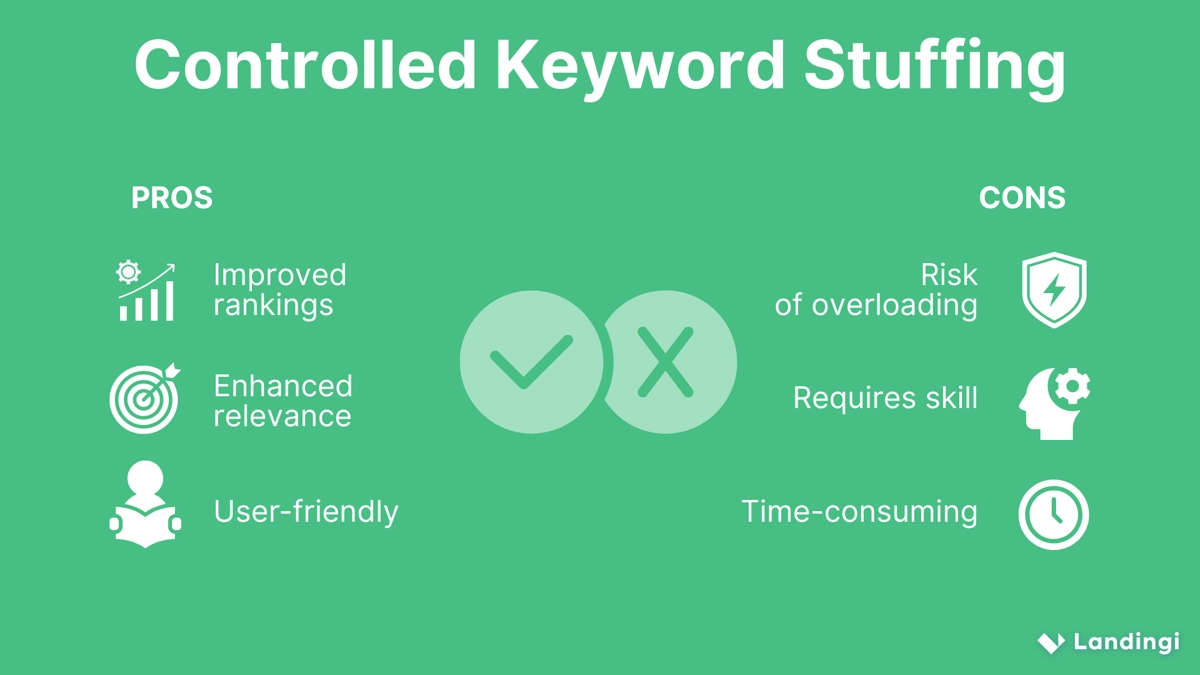
Example: If you’re writing a blog post about “best dog food for puppies,” instead of just repeating that phrase, you might naturally include variations like “nourishing meals for young dogs” or “nutritional choices for growing puppies” within relevant sections of your comprehensive guide.
Let AI do the heavy lifting! Build smarter, high-converting landing pages with Landingi’s AI tools.
Content Spinning and Automation
Content spinning involves taking existing text and automatically rephrasing it to create new, unique versions. While tempting for rapid content generation, doing this carelessly can quickly lead to low-quality, unreadable material. When approached safely, this tactic is about modestly leveraging automation tools to assist, not replace, human writing, aiming to produce genuinely distinct pieces without generating obvious duplicate content.
The key is meticulous manual review and editing to transform automated output into truly high-quality content that adheres to search engine policies and provides real value to readers. It’s a risky balance, demanding precision to avoid penalties while still gaining some efficiency.
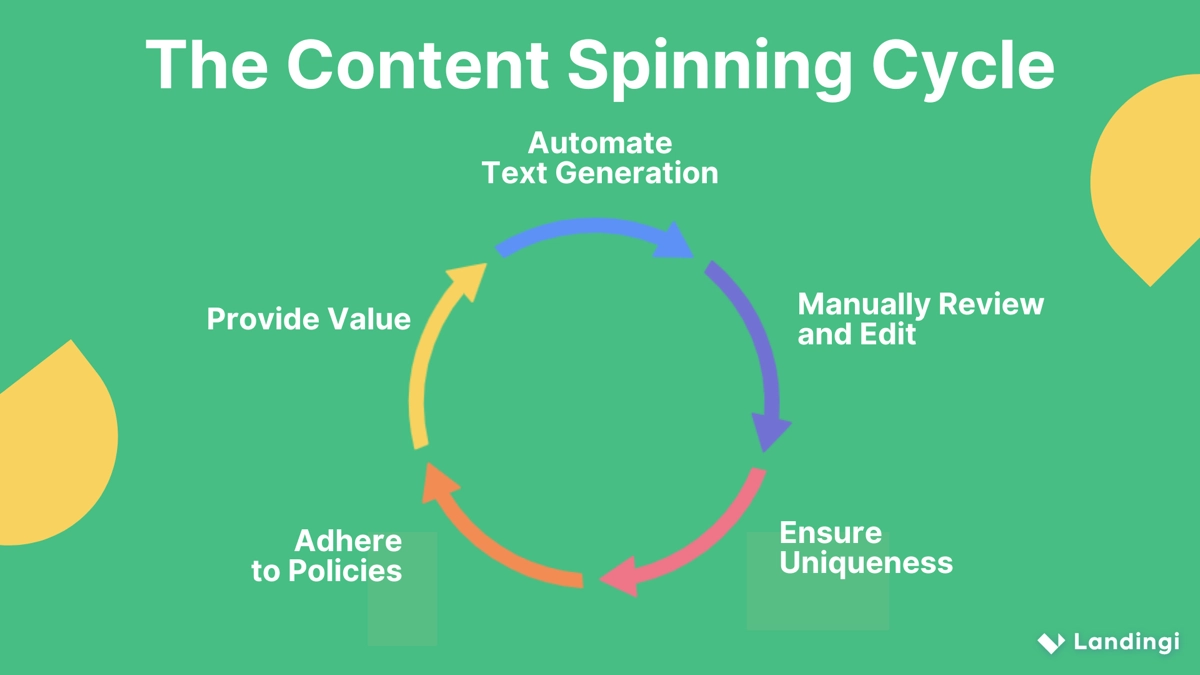
Example: Instead of spinning an entire article, you might use an automation tool to quickly generate several variations of a product description for an e-commerce site. However, each version would then undergo thorough human editing to ensure it sounds natural, is grammatically perfect, and provides clear, unique value to the customer, rather than just being a reworded copy.
Buying Expired Domains
Buying expired domains involves acquiring website addresses that were once active but have since become available for purchase. The primary allure is their existing backlink profile, which can carry significant SEO value from years of previous activity. When approached safely, this isn’t about spamming but finding domains with clean histories and genuinely relevant, high-quality links that align with your new site’s niche.
The goal is to leverage their past authority to boost your new site‘s rankings and organic traffic more quickly than starting from scratch. However, meticulous analysis is crucial to avoid inheriting penalties or poor-quality associations.
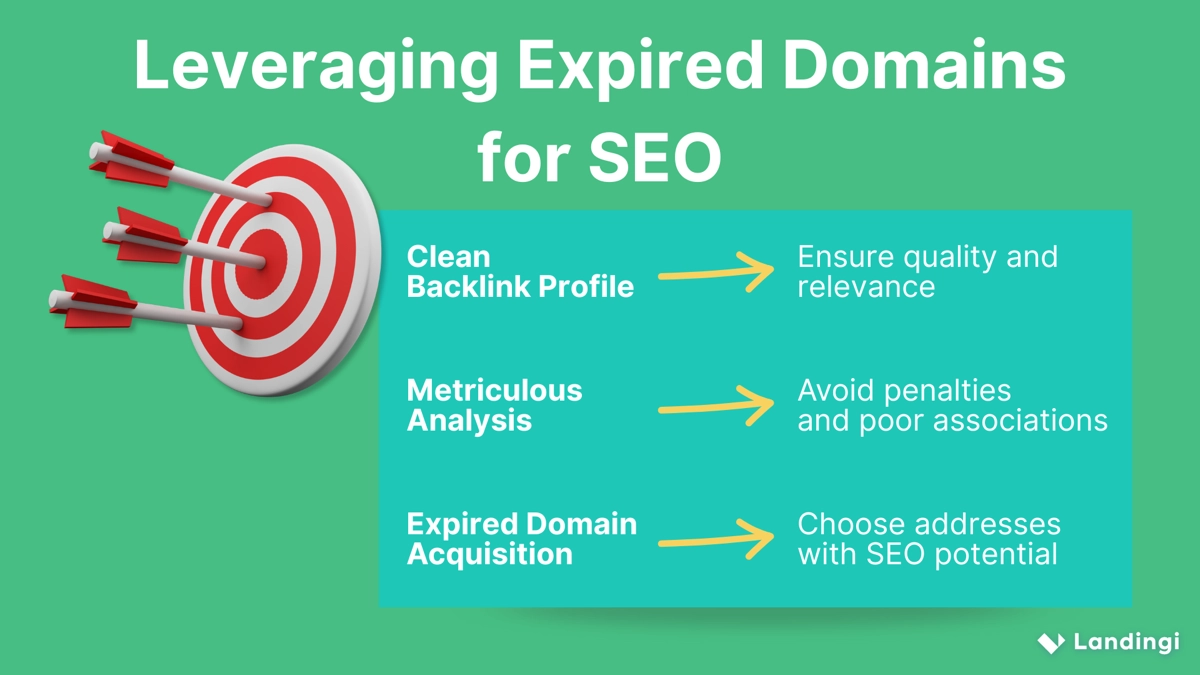
Example: A marketer launching a new blog about sustainable living might look for an expired domain that previously belonged to an eco-friendly product review site. If that old domain has a clean past and numerous natural backlinks from reputable environmental blogs, acquiring it could provide a significant head start in terms of authority and discoverability for the new content.
Private Blog Networks (PBNs)
Private Blog Networks (PBNs) are essentially a collection of websites, often built on expired domains, secretly owned by one entity and used solely to build links back to a “money site.” While they can be a potent way to boost authority quickly, they are a high-risk grey hat tactic. To approach them “safely”, the focus must be on making each site in the network appear completely independent and natural. This means diverse hosting, unique and genuinely valuable content on each PBN site, varied themes, and a cautious approach to linking to avoid leaving obvious footprints for search engines to detect. The goal is little manipulation, designed to mimic organic link acquisition.
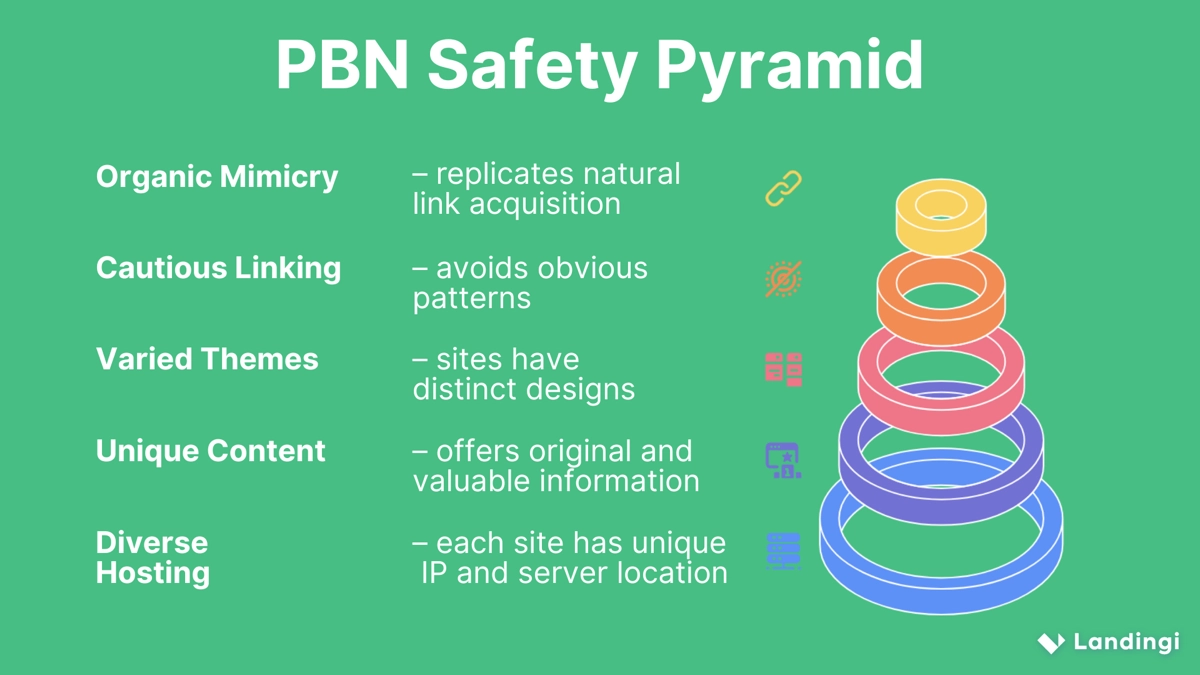
Example: Instead of creating ten identical sites all linking to your main e-commerce store, you might build three distinct blogs, each with unique content on related but different sub-niches (e.g., “Sustainable Gardening Tips,” “Home Composting Guides,” “Eco-Friendly DIY Projects”). Each blog would have different hosting providers and genuinely helpful articles, with only occasional, contextually relevant links back to your main site’s specific product categories.
Social Media and Bookmarking
This strategy entails leveraging different social media platforms and bookmarking sites to share your content and create backlinks to your website. While inherently white hat when done genuinely, it veers into grey hat territory when accounts are created solely for link signals or automation is used excessively.
To minimize risks, focus on organic, high-quality engagement: share truly valuable content, use relevant hashtags, and build a real following. The goal is to attract real visitors and gather genuine user feedback. This way, any benefits from links come naturally from valuable actions instead of forced tactics.
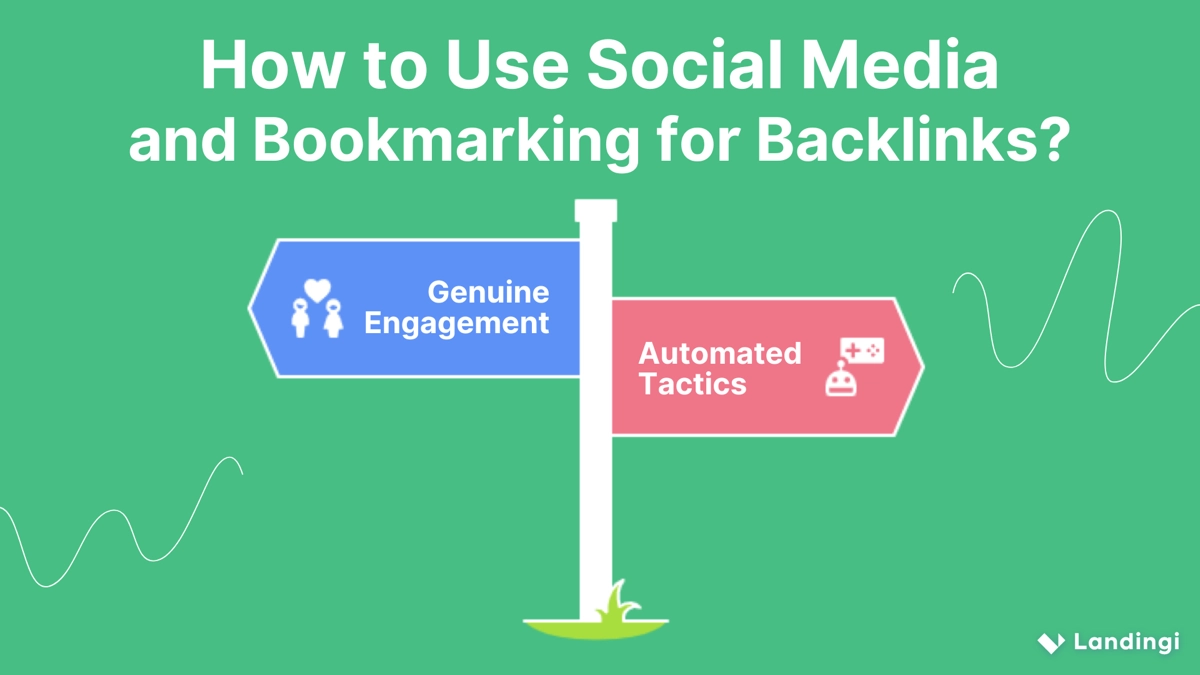
Example: Instead of creating dozens of fake Twitter accounts to simply tweet links to your new article, you’d focus on genuinely engaging with relevant communities on a few established profiles. You might share your blog post on Reddit in a relevant subreddit, but only after participating in discussions and ensuring your post provides real value to that community, rather than just acting as self-promotion.
4. Monitor Performance
Once your grey hat tactics are in play, the fourth critical step is to continuously monitor performance.This isn’t just about watching your search rankings climb (or fall) but about diligently tracking every indicator that could signal success or, more importantly, a potential problem. You need to keep a close eye on your organic traffic levels, looking for any sudden spikes or, conversely, unexplained drops that might hint at an algorithmic penalty.
Dive into metrics like bounce rate, time on page, and conversion rates. Are these new tactics actually bringing in engaged users who convert, or just low-quality visitors? Crucially, use tools like Google Search Console to watch for manual actions or crawl anomalies. Constant vigilance allows you to quickly detect if your grey hat moves are yielding positive results or if it’s time to adjust course immediately before any minor issue escalates.
Example: If you’ve implemented a controlled keyword stuffing strategy on a set of blog posts, you’d monitor their organic traffic in Google Analytics, track their keyword rankings in a tool like Ahrefs, and most importantly, check Google Search Console daily for any “manual actions” related to keyword spam. If you notice a sudden dip in traffic for those pages without a clear external reason, or a warning in Search Console, it’s a strong signal to either dial back the density or re-evaluate the content.
Take control of your SEO and conversions. Use EventTracker and optimize pages for better results.
5. Prioritize User Experience and Value
Even when experimenting with grey hat tactics, it’s absolutely crucial to never compromise on user experience (UX) and the genuine value your content provides. While some techniques might aim to influence search engines, their ultimate success hinges on how real users interact with your site. If your tactics degrade readability, create confusing navigation, or lead to low-quality content, users will quickly bounce, sending negative signals to search engines and undoing any potential gains.
Always strive for a balance where any grey hat efforts are so subtle they remain invisible to the user, ensuring their journey on your site is smooth, engaging, and genuinely helpful. Your core mission should always be to deliver an exceptional experience, regardless of the behind-the-scenes strategies you’re employing.
Example: If you’re implementing controlled keyword stuffing, make sure the sentences still flow naturally and provide clear information, rather than sounding repetitive or forced. Similarly, if you’ve acquired an expired domain, ensure the content you put on it is high-quality and relevant to its historical links, offering true value to visitors who might land there, instead of just being a shell for passing link juice.
6. Review Your Methods
The final, crucial step in your grey hat journey is an ongoing, rigorous review of your methods – in this area, what worked last month might be a red flag today. This means consistently auditing your implemented tactics, analyzing their long-term impact on your site’s health, and staying ahead of search engine updates.
Don’t fall into the trap of setting and forgetting. Actively seek out information on recent algorithm changes and evolving best practices. If a tactic starts to show diminishing returns, or worse, negative signals, be ready to pivot immediately. This continuous reassessment allows you to refine your approach, ensuring your grey hat efforts remain as low-risk and impactful as possible.
Example: If you’ve been using reciprocal links, regularly check the health of your linking partners to ensure they haven’t been penalized or become irrelevant. For PBNs, periodically review their content quality and link patterns to ensure they still appear natural and aren’t leaving obvious footprints. A monthly check-up of your Google Search Console for any new warnings or traffic drops related to specific tactics can be your early warning system, prompting you to adjust or even abandon a method that’s no longer viable.
Should I Implement Greyhat SEO Methods?
You can use greyhat SEO methods, but only if you’re willing to accept higher risk for faster gains. These strategies can offer quicker traffic and better rankings than standard white hat techniques, but they operate close to the edge of search engine rules.
Using grey hat SEO may help in competitive niches where safe, tailored to search engine guidelines methods alone don’t bring results. However, any benefit comes with the risk of penalties, especially during core updates. If you’re running a long-term brand or business, even a single hit can lead to major visibility loss or domain devaluation.
Greyhat SEO is best suited for short-term projects, experiments, or aggressive scaling where the consequences are acceptable. For stable, lasting growth and secured search results positions, prioritize sustainable content and authority.
How to Choose the Best Greyhat SEO Services?
To choose the best greyhat SEO services, check how they handle risk without crossing the line. A good provider blends aged domains, content rewrites, and guest posts into a natural backlink profile. They adapt quickly to updates, track patterns, and apply techniques that improve search engine rankings without leaving obvious traces.
Avoid firms that overpromise or hide methods – clarity means control. The best ones operate quietly, test often, and focus on steady gains rather than fast spikes.
How to Become a Greyhat SEO Expert?
To become a greyhat SEO expert, first, forge an unshakeable white hat SEO foundation and truly grasp how search engines should work, then evaluate risks, and experiment on non–critical projects to gain practical experience. A deep understanding of search engine guidelines reveals the grey zones, showing you potential opportunities to leverage strategic advantages without triggering penalties, enabling superior results through informed decision-making.
Risk assessment is crucial, as every grey hat tactic has a penalty ceiling, and an expert knows how to dance beneath it. Continuous learning is non-negotiable because algorithms shift constantly, demanding adaptability. At this point, you need to practice, but remember, an expert does not risk their main asset for short-term gains. They always balance smart innovation with careful risk management.
This path demands sharp discipline and keen analytical skills, not impulsiveness. It’s about strategic advantage and informed decision-making. Remember: becoming a grey hat SEO expert isn’t about reckless rule-breaking but more about mastering the nuanced art of balancing short–term gains with long–term site integrity and navigating the ever–shifting line between acceptable tactics and risky penalties.
What is the Difference Between Greyhat SEO and Blackhat SEO?
The key difference between greyhat SEO and blackhat SEO lies in intent and risk. Black hat SEO breaks Google’s rules directly (think cloaking, link farms, hidden text). Grey hat SEO tactics play in the gray zone, exploiting loopholes without clear violations. Black hat techniques risk fast penalties, while grey methods aim for safer short-term wins. One gets punished quickly, the other is tested quietly. Ultimately, it’s the intent to manipulate without obviously breaking the rules that defines the gray approach.
What is the Difference Between Greyhat SEO and Whitehat SEO?
The difference between greyhat and whitehat SEO is that whitehat SEO follows Google’s rules, while greyhat bends them without breaking. White hat SEO techniques rely on clean content, natural links, and user value. Grey methods look for shortcuts: safe for now, risky later. White hat vs. grey hat SEO is long-term trust versus faster, uncertain gains. The twist? Some top-ranking sites quietly run both.
What is the Best Greyhat SEO Tool?
In fact, no single tool labels itself “best grey hat SEO tool”, but marketers often combine several SEO tools to implement chosen grey hat tactics, measure SEO performance, and detect potential problems at their early stages. So, take a look at the tools that can be strategically leveraged to navigate this complex area, offering insights and capabilities that support your calculated grey hat endeavors.
Screaming Frog
Screaming Frog remains the gold standard for technical SEO audits, which is crucial when managing multiple sites or PBNs – a common greyhat method. It quickly identifies technical issues, duplicate content, and crawl problems that could expose greyhat activities to search engines.
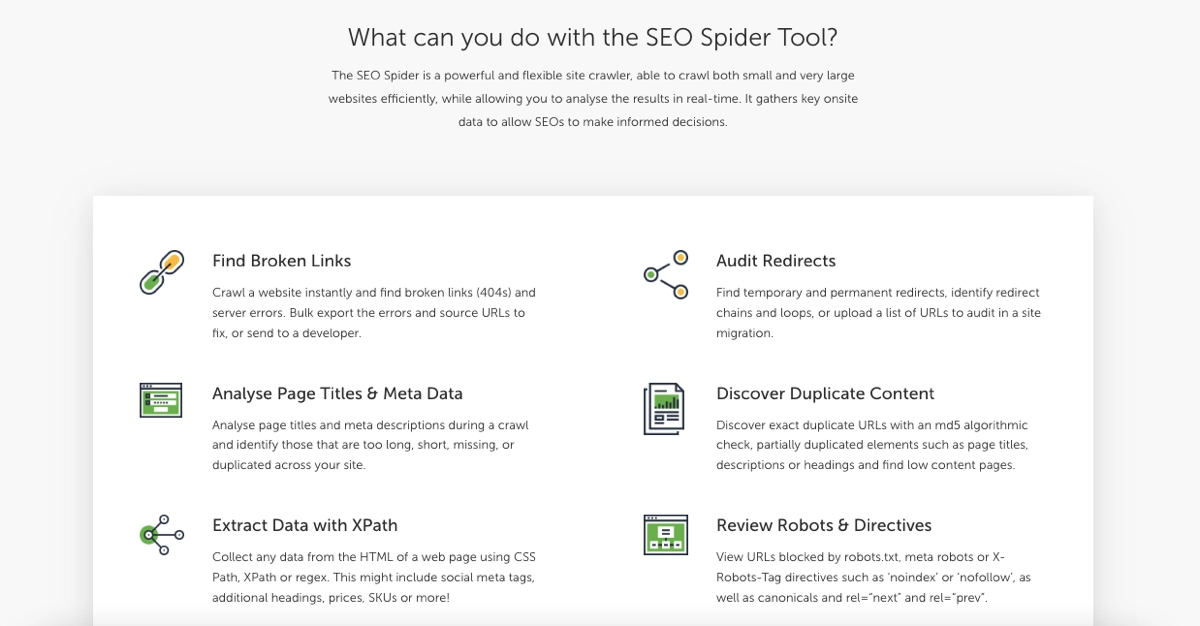
AI-Powered Tools
Tools that operate on artificial intelligence, like Chat GPT or SEO.AI, are increasingly valuable for automating content creation, spinning, and optimization at scale – key components of greyhat SEO. These tools can generate unique content variations, optimize for specific keywords, and even help with cloaking or content tailoring for different audiences.
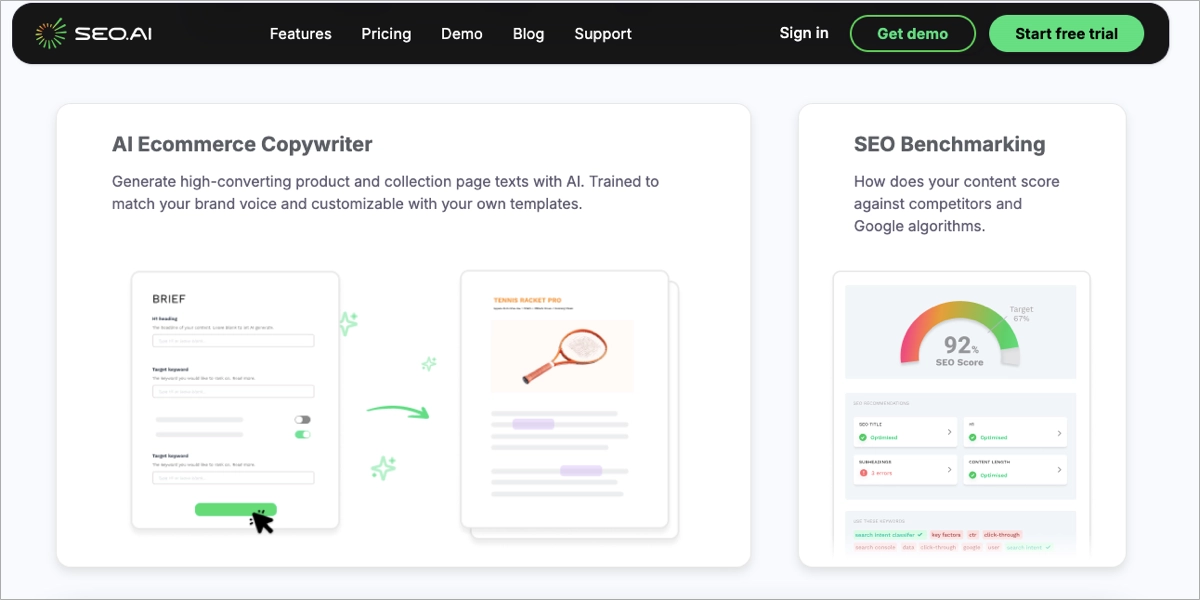
Semrush
Semrush is an all-in-one powerhouse, excelling at competitive analysis, keyword research, and site audits. Its robust feature set supports a variety of greyhat approaches, including content syndication and advanced link–building tactics.

Other tools that marketers can use for greyhat SEO strategies involve Spin Rewriter, which helps automate rewrites (but manual cleanup is essential to dodge duplicate-content flags), or social media automation bots, which can boost engagement signals.
What is the Role of Landing Pages in Greyhat SEO?
Landing pages in grey hat SEO act as traffic funnels – they’re often optimized for exact–match queries, used to test keywords, or built to pass link equity to core pages. Their role is simple: attract clicks, boost CTR, build authority fast, then redirect or rewire once they’ve done their job. They’re quiet workers in a louder system.
Some practitioners take an aggressive approach to landing page optimization, employing techniques like misleading calls-to-action or hidden offers to maximize conversions from the traffic acquired through manipulative SEO methods. While optimizing for conversions is standard practice, the use of deceptive or ambiguous tactics crosses into greyhat territory.
From strategy to execution – Landingi helps you create pages that enhance your SEO performance.
What Are the Limitations of Greyhat SEO?
Greyhat SEO, because it sits between recommended white hat SEO tactics and outright dishonest black hat SEO, inherently carries significant limitations, such as unclear long-term stability, higher risk of penalties during algorithm updates, and lack of official support from search engines.
Without a proper understanding of its nuances, there’s a constant risk of misinterpretation, leading to actions that could trigger severe penalties from search engines. It’s a high-stakes gamble, where a misstep can result in drastic ranking drops, de-indexing, or even pave the way for negative SEO attacks if your methods are too easily detectable. Operating in this grey zone means navigating ambiguous SEO guidelines, constantly adapting to algorithmic shifts, and accepting that any short-term gain is often accompanied by a risk to the long-term stability and reputation of the brand.
Use Greyhat SEO to Improve Traffic on Your Landing Pages
Strategic greyhat methods can give your landing pages the early momentum they need – more traffic, better rankings, stronger visibility.
When thoughtfully combined with smart design principles and rapid A/B testing, these tactics transform into powerful catalysts for growth. Landingi empowers you to build high-performing pages without a single line of code, making it effortless to apply what truly works. Ready to see the difference? Start your free trial now and give your best ideas the launch boost they deserve.






